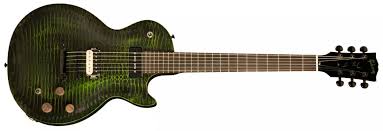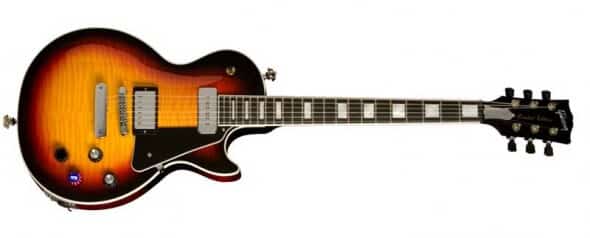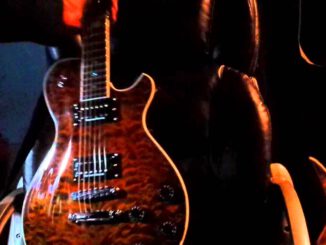
For a little bit of money, nearly any guitar of standard design (Teles, Strats, Les Pauls, SGs) can be clad in a full-wraparoud graphic decal. Common themes of such artistic measures include lightning bolts, snake skins, glowing cracks and the like. The attraction of such cladding is that the look of your guitar can be altered dramatically without the effort, cost and time consumption involved in stripping and repainting – something which is done all the time in those dark buildings where musical instruments are born.
Such dramatic and ornate guitars have generally been an expensive proposition, the domain of short-run producers with high-quadruple-digit price tags – and you take your chances on the quality of the lute itself where tone, balance, features and playability are concerned. In many instances, you really don’t know what will greet your ears until the bill has been paid, a big chance to take with big money on the line.
The third option, having your existing guitar custom-painted to your preference, fades away quickly as the costs mount – it is no small endeavor to disassemble a guitar, strip it to the bare wood and re-coat it in an artistic fashion. Compared even to the cost of a new guitar, this isn’t something that many people would want done, unless they had the skills and resources to pull the job off themselves – only a select group of individuals need apply.
Even so, graphically enhanced guitars have been chewing up more and more market share in recent years, and the world’s premier manufacturer of electric guitars has taken notice as Gibson has unveiled their new Les Paul BFG Gator.
The BFG line of Les Pauls has been well-received by the public. The “photo-finish” archtop, which remove so much of the woodworking from the process, allows Gibson to sell the Les Paul at prices comparable to what people have always been willing to pay for standard American Fenders. A Les Paul Custom, costing three times as much (or more), may not be accessible to the average workaday strummer, but the BFG line is, and by the looks of it, the new Gator LP is poised to be a big seller.
The high-gloss nitrocellulose finish protects a stunning black-and-green alligator skin graphic that cannot be passed over by any set of eyeballs. The sheer Wow Factor is on par with any air-brushed custom guitar, and blows away those decals that would attempt to emulate such a look. Best yet, underneath the scales and the swampy green highlights lies the sort of tone monster that one would expect from any guitar bearing Les Paul’s name on the headstock, even if it appears in lime-green lettering.
The Gator, like others in the BFG line, is somewhat stripped down compared to some of the more expensive Gibsons, with twin tone controls and one volume (on this particular model, the wooden knobs nicely complement the Gator’s bayou-esque look and feel). The all-black chrome hardware – including 18:1 Grover tuners and Tune-o-Matic bridge – lend to the guitar’s foreboding look.
The Les Paul Gator BFG produces a great sound one would expect — with a sizzling P90 in the neck position to go with the zebra Burstbucker 3 (both hand-wound with Alnico magnets) in the bridge. Anyone who has been lucky enough to play a P90-equipped guitar will drool just from reading that sentence, as no other single-coil pickup can produce such high-flying tones. Coupled with the proven growl and grunt of the uncovered Burstbucker this Gibson will make noises that much higher-priced instruments can’t emulate. The white end of the double-coil bridge pickup anchors the Gator’s look against the white Corian nut at the opposite end – the only two slices of brightness amidst the prehistoric black-and-green motif.
The one extra that Gibson threw in to separate the Gator from its peers on the shelf is the kill-switch (which is mounted in the usual 3-way selector position, with the actual 3-way moved down by the control knobs). This will no doubt attract a following unto itself, as many players in this era of modification have fallen head-over-heels for such gadgetry.
The moustache headstock, sitting atop the ’50s style round-profile neck – which is set in, not bolted on – readily identifies this guitar as the genuine article. The naked rosewood fretboard sans inlays or markings may or may not have personal appeal to everyone, but either way, it finishes out the look of the guitar by keeping the eyes focused where they should be: On the scaly belly of this impressive beast. The chambered body, which has successfully shoved a bigger and brighter sound out of other Les Pauls (even those of the Epiphone variety), amounts to the cake under the icing.
Priced at a mere (for Gibson) $1,079, the BFG Gator may well push others aside for buyers who are looking for the next addition to their collection. Uniquely guttural and gorgeous, and affordable to boot, this Gator will put other “artsy” axes to shame and is guaranteed to have you chasing its tail.





Be the first to comment